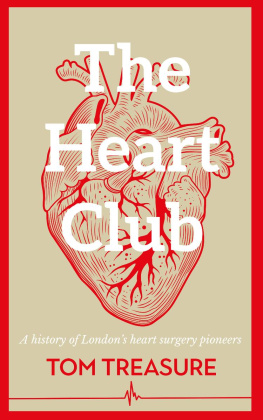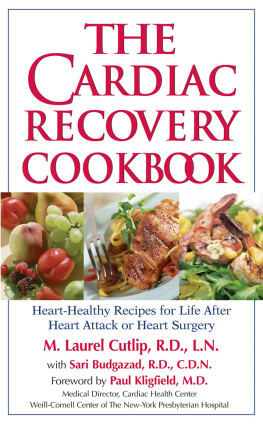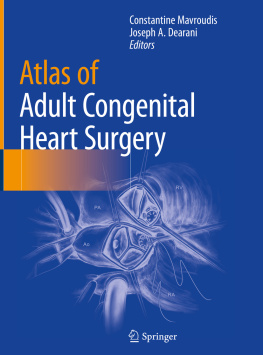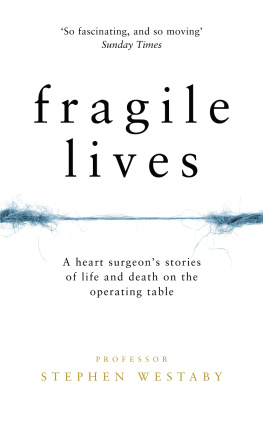Tom Treasure - The Heart Club: A History of Londons Heart Surgery Pioneers
Here you can read online Tom Treasure - The Heart Club: A History of Londons Heart Surgery Pioneers full text of the book (entire story) in english for free. Download pdf and epub, get meaning, cover and reviews about this ebook. year: 2017, publisher: Clink Street Publishing, genre: Detective and thriller. Description of the work, (preface) as well as reviews are available. Best literature library LitArk.com created for fans of good reading and offers a wide selection of genres:
Romance novel
Science fiction
Adventure
Detective
Science
History
Home and family
Prose
Art
Politics
Computer
Non-fiction
Religion
Business
Children
Humor
Choose a favorite category and find really read worthwhile books. Enjoy immersion in the world of imagination, feel the emotions of the characters or learn something new for yourself, make an fascinating discovery.
- Book:The Heart Club: A History of Londons Heart Surgery Pioneers
- Author:
- Publisher:Clink Street Publishing
- Genre:
- Year:2017
- Rating:3 / 5
- Favourites:Add to favourites
- Your mark:
- 60
- 1
- 2
- 3
- 4
- 5
The Heart Club: A History of Londons Heart Surgery Pioneers: summary, description and annotation
We offer to read an annotation, description, summary or preface (depends on what the author of the book "The Heart Club: A History of Londons Heart Surgery Pioneers" wrote himself). If you haven't found the necessary information about the book — write in the comments, we will try to find it.
Tom Treasure: author's other books
Who wrote The Heart Club: A History of Londons Heart Surgery Pioneers? Find out the surname, the name of the author of the book and a list of all author's works by series.
The Heart Club: A History of Londons Heart Surgery Pioneers — read online for free the complete book (whole text) full work
Below is the text of the book, divided by pages. System saving the place of the last page read, allows you to conveniently read the book "The Heart Club: A History of Londons Heart Surgery Pioneers" online for free, without having to search again every time where you left off. Put a bookmark, and you can go to the page where you finished reading at any time.
Font size:
Interval:
Bookmark:
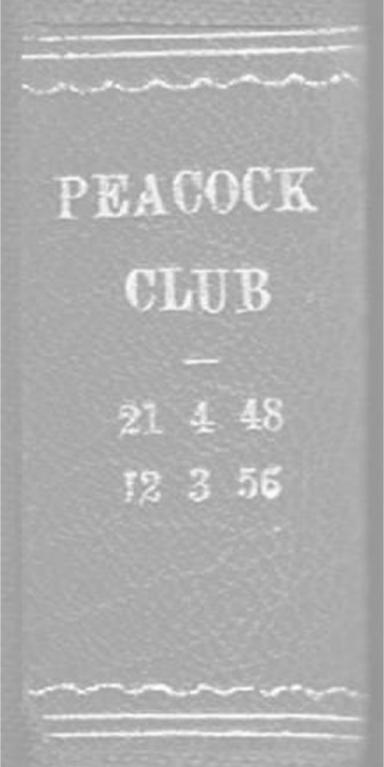
To the memory of the doctors of the
Peacock Club and their patients.
Many people have helped me in conversations, as sources of information and in reflection on where the events in this book sit not only in the history of medicine but in social history and humanity. Most of the many who helped me are listed formally in the Preface. Those I might have forgotten, please feel included in my gratitude for helping me in this task which has been the product of years of deliberation. Particularly I thank John Chambers for finding the book, Christopher Lawrence for mentoring me and Caroline Coates who curates Arthur Hollman Collection at the British Cardiovascular Society and has taken the Minutes of the Peacock Club into safe keeping.
I am especially grateful to Gareth, Hayley, Josh and Kate at Clink Street for guiding this book into print.
Central to this book are the Minutes of the Peacock Club. These are the consecutive accounts of 47 meetings in Guys Hospital from April 1947 to March 1956. They are in a small bound volume which is now in the historical collection of the British Cardiovascular Society in Fitzroy Square in London. The volume was found by Dr John Chambers among books and papers on the shelves of Guys cardiology department. The building, the old Hunts House, was demolished not long afterwards and the Minutes might easily have been lost had John Chambers not saved them.
The work of the Peacock Club is recorded in the Minutes of 47 meetings from 1948 to 1956 but as to the history of the volume itself I am left guessing. The bound volume is made up of several exercise books with ruled pages. Some of the earlier minutes were hand written. Later they were more often typed and pasted onto the pages. The minutes clearly antedate the binding because in several instances, marginal content has been lost due to cropping in the binding process. The Minutes were routinely signed and dated. The date on which they were signed matches that of the next meeting, so they are consecutive. The last Minute is for March 1956 and is unsigned; it appears that there was no subsequent meeting at which to sign them. The year coincides with Maurice Campbell retiring from Guys Hospital. From then, who was the custodian of the Minutes and who had them bound? At this point I do not know.
In 1951 in the first few years of the Club Russell Brock wrote:
Intracardiac surgery is not for the lone worker. Team work is essential. To give one example, at Guys there is a group of some 15 people actively engaged in the work, and as time passes we find that more and more are drawn into the team.
The group he refers to was the Peacock Club. But why the name Peacock? It is explained in the first few meetings. The Club was named after Dr Thomas Peacock. In his 1858 book on malformations of the human heart he gave a clear description of the four components of the congenital malformation, generally known as Fallots Tetralogy.
As a guide to navigating this book the headings below indicate the contents of the successive chapters. The chapters are interrelated to some degree but are self-contained and do not have to be read consecutively.
This first chapter sets the scene in London 1945 when Guys Hospital began to function normally again. The medical and outpatient work of the hospital returned from Orpington in Kent where it had been since 1939 under the leadership of Dr Maurice Campbell. Russell Brock had remained in London while the hospital suffered bombing and fire damage. Campbell and Brock are central to this story. From the relative safety of Tunbridge Wells, the students and preclinical teachers of the medical school came back to Guys. Dr Boland, back from the North African theatre of war, was made their Dean. He immediately set about establishing exchange visits for the clinical teachers with Johns Hopkins Hospital in Baltimore, the first of whom was Alfred Blalock. The chapter closes with the founding of the Peacock Club.
The Minutes of the 47 meetings have been transcribed and presented complete. Footnotes signpost further information and explanations in the look-up lists near the end of the book but the Minutes largely speak for themselves. The full contents of the Minutes, in their original appearance, are available as .jpg files from the archive of the British Cardiovascular Society. I have therefore made an editorial decision to present an easy to read version of what the writers of the Minutes intended to be understood, rather than struggling to attempt a facsimile through modern software. So I have not reproduced typographical errors, the forensic evidence of hand written corrections, variations in punctuation, or obvious spelling errors. But contemporary usual spelling and usages have been preserved, for example the alternative spelling of shew for our usual show has not been changed. Where there are possible uncertainties, such as the identity of individual names due to spelling variations in the original, this is indicated. There remains some variation in the format of the minutes reflecting the variety of hands that played a part in keeping the record. Selected pages are interposed as scanned images of the original and there are illustrations from contemporary publications.
The meeting headlines I have provided at the beginning of the Minutes suggest three overlapping phases of the meetings. At first, they were getting organised and learning how to select and investigate patients for operations which were new and experimental. In the middle phase, they were presenting their on-going laboratory and clinical research. In the third phase, there were studies of the outcomes of their operations. Throughout the Minutes there are presentations of clinical cases for the team to review so they could improve their selection and operations. Research work was presented in preparation for its publication. By tracing the authors and their written output we can track the stages of dissemination from Guys Hospital Reports, through the British Heart Journal and the British Medical Journal to specialist and international journals.
I have been fortunate to have met and to work with three remarkable people who were treated for congenital heart disease in the 1950s John Hunt, Xerxes Talati and Geraldine West. They tell their own life stories. I am grateful to Dr Kate Bull for introducing me to them. Through their sometimes complicated lives they all were treated at some stage by doctors of the Peacock Club. Their stories chart the developments, and some of the sequelae of this earliest surgery for congenital heart disease, up to the present day.
The first two (of five) look-up lists are brief biographies. List 1 is of those who attended the club. As Brock wrote in 1951 there was a nucleus of about 15 people actively engaged in the work at any particular time.people were evolved as new members of staff were appointed and trainees, residents, clinical and research staff came and went. As a result, outside the nucleus of 15 or so, many were young, in their mid-twenties to early thirties. There were over 40 attendees as members, of which only two were women. In addition, nearly 50 visitors are named. In the later years, attendance lists were not kept so there were probably many more occasional visitors.
Font size:
Interval:
Bookmark:
Similar books «The Heart Club: A History of Londons Heart Surgery Pioneers»
Look at similar books to The Heart Club: A History of Londons Heart Surgery Pioneers. We have selected literature similar in name and meaning in the hope of providing readers with more options to find new, interesting, not yet read works.
Discussion, reviews of the book The Heart Club: A History of Londons Heart Surgery Pioneers and just readers' own opinions. Leave your comments, write what you think about the work, its meaning or the main characters. Specify what exactly you liked and what you didn't like, and why you think so.

